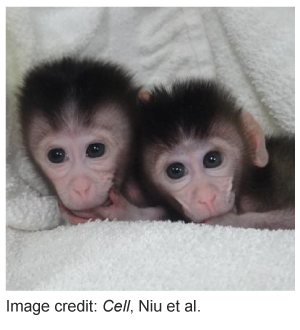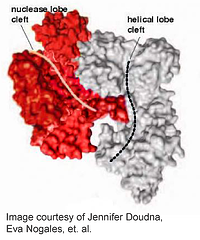 If any of you are finding it hard to keep up with the news on CRISPR, there's a pretty good reason for that. Lately, significant advances in the understanding and application of CRISPR/Cas9 technology are coming along at a fast and furious pace. In December, as we've blogged about before, there was the first direct demonstration that CRISPR's could be used to correct disease mutations, both in mice and in human cells. But that important advance was quickly followed by even splashier news: Jiahao Sha of Nanjing Medical University had successfully used the CRISPR/Cas9 system to precisely edit specific genes in monkeys.
If any of you are finding it hard to keep up with the news on CRISPR, there's a pretty good reason for that. Lately, significant advances in the understanding and application of CRISPR/Cas9 technology are coming along at a fast and furious pace. In December, as we've blogged about before, there was the first direct demonstration that CRISPR's could be used to correct disease mutations, both in mice and in human cells. But that important advance was quickly followed by even splashier news: Jiahao Sha of Nanjing Medical University had successfully used the CRISPR/Cas9 system to precisely edit specific genes in monkeys.
"Our study shows that the CRISPR/Cas9 system enables simultaneous disruption of two target genes in one step without producing off-target mutations," Sha was quoted as saying when the news first broke. "Considering that many human diseases are caused by genetic abnormalities, targeted genetic modification in monkeys is invaluable for the generation of human disease models."
Addgene Outreach Scientist and fellow blogger Caroline LaManna put it well: "Wow, custom mutations in monkeys already. I know we've discussed it before, but CRISPRs allow research to move so fast."
On the very same day the monkey story hit the presses, another very different bit of CRISPR news was circulating. Scientists at North Carolina State, in the labs of Chase L. Beisel and Rodolphe Barrangou, had applied the CRISPR/Cas9 system to developing an antibiotic that selectively kills only the bacteria you want it to, leaving all those healthy bugs in the human microbiome alone. (Seriously, is there anything CRISPRs can't do?)
Structural details
 All this, and scientists are still working out important details in their understanding of how CRISPR/Cas9s actually work. Last month, the Lawrence Berkeley Lab's Jennifer Doudna and Eva Nogales presented the first detailed picture of Cas9's three-dimensional shape via x-ray crystallography, an advance they say should allow scientists to develop it as an even more precise and useful tool. A week later, researchers at the Broad Institute and MIT published another report showing Cas9's structural details.
All this, and scientists are still working out important details in their understanding of how CRISPR/Cas9s actually work. Last month, the Lawrence Berkeley Lab's Jennifer Doudna and Eva Nogales presented the first detailed picture of Cas9's three-dimensional shape via x-ray crystallography, an advance they say should allow scientists to develop it as an even more precise and useful tool. A week later, researchers at the Broad Institute and MIT published another report showing Cas9's structural details.
"Understanding this structure may help us engineer around the current limitations of the Cas9 complex," said study author F. Ann Ran, a graduate student in Feng Zhang's lab, in a press release. "In the future, it could allow us to design versions of these editing tools that are more specific to our research needs. We may even be able to alter the type of nucleic acid sequences that Cas9 can target."
As further proof of just how big and mainstream the news on CRISPR has gotten, consider these headlines in The New York Times and Forbes respectively: "A Powerful New Way to Edit DNA" and "This Protein Could Change Biotech Forever." David S. Weiss of Emory University summed it up well in that New York Times feature when he said, “All of this has basically happened in a year. It’s incredible.”
Looking for CRISPR Plasmids?
References:
Generation of Gene-Modified Cynomolgus Monkey via Cas9/RNA-Mediated Gene Targeting in One-Cell Embryos. Niu Y, et al. Cell. 2014 January 30. (Pubmed)
Programmable Removal of Bacterial Strains by Use of Genome-Targeting CRISPR-Cas Systems. Ahmed A. Gomaa, et al. mBio. 2014 January 28. (Article).
Read More:
Topics: CRISPR







Leave a Comment